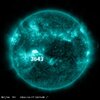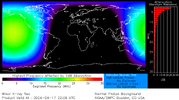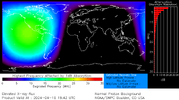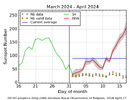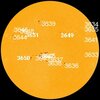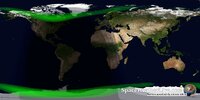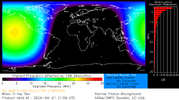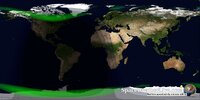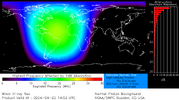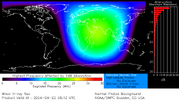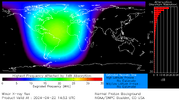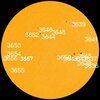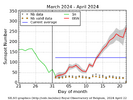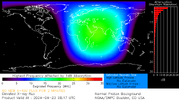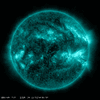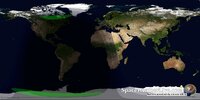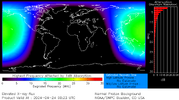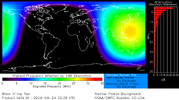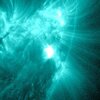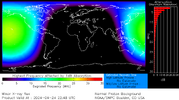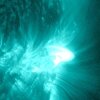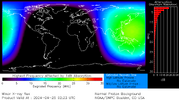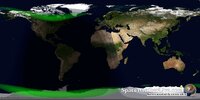SOLAR CYCLE ACTIVITY REPORT APRIL 17_2024
Solar activity has been at moderate levels for the past 24 hours. The largest solar event of the period was a M1 event observed at 1802 UTC from Region 3643 (S13E48). The flare generated a Minor R1 radio blackout over North and Central America.
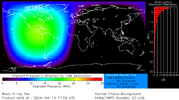
The total number of sunspots has decreased to 176 of which 66 of them are grouped into 11 active regions as follows:
○AR3633/ 3 sunspots / 80MH,
○AR3634/ 9 sunspots/ 310MH
○AR3635/ 3 sunspots/ 10MH
○AR3636/ 3 sunspots/ 90MH
○AR3637/ 2 sunspots/ 20MH
○AR3638/ 8 sunspot/ 80MH
○AR3639/ 19 sunspots/ 310MH
○AR3641/ 6 sunspots/ 110MH
○AR3642/ 5 sunspots/ 10MH
○AR3643/ 6 sunspots/ 100MH
○AR3644/ 2 sunspots/ 80MH (new region)

AR3628 & AR3640 are gone
NOAA's forecast for the next 24 hours: 99% chance of C flares, 60% chance of M flares and 10% chance of X flares.
Sunspots AR3737 and AR3643 have developed beta-gamma magnetic fields that harbor energy for M-flares, while AR3639 has a "beta-gamma-delta" magnetic field that poses a threat to X-class solar flares.
● Auroral Activity
The geomagnetic field has been at unsettled to minor storm levels. On April 16 a Minor G1 geomagnetic storm (Kp5) occurred at 19:10 UTC. Solar wind speed reached a peak of 422 km/s (Elevated speed) at 15:46 UTC Total IMF reached 13 nT at 13:04 UTC.
Solar activity has been at moderate levels for the past 24 hours. The largest solar event of the period was a M1 event observed at 1802 UTC from Region 3643 (S13E48). The flare generated a Minor R1 radio blackout over North and Central America.

The total number of sunspots has decreased to 176 of which 66 of them are grouped into 11 active regions as follows:
○AR3633/ 3 sunspots / 80MH,
○AR3634/ 9 sunspots/ 310MH
○AR3635/ 3 sunspots/ 10MH
○AR3636/ 3 sunspots/ 90MH
○AR3637/ 2 sunspots/ 20MH
○AR3638/ 8 sunspot/ 80MH
○AR3639/ 19 sunspots/ 310MH
○AR3641/ 6 sunspots/ 110MH
○AR3642/ 5 sunspots/ 10MH
○AR3643/ 6 sunspots/ 100MH
○AR3644/ 2 sunspots/ 80MH (new region)

AR3628 & AR3640 are gone
NOAA's forecast for the next 24 hours: 99% chance of C flares, 60% chance of M flares and 10% chance of X flares.
Sunspots AR3737 and AR3643 have developed beta-gamma magnetic fields that harbor energy for M-flares, while AR3639 has a "beta-gamma-delta" magnetic field that poses a threat to X-class solar flares.
● Auroral Activity
The geomagnetic field has been at unsettled to minor storm levels. On April 16 a Minor G1 geomagnetic storm (Kp5) occurred at 19:10 UTC. Solar wind speed reached a peak of 422 km/s (Elevated speed) at 15:46 UTC Total IMF reached 13 nT at 13:04 UTC.
ANOTHER CME IS COMING: A faint CME left the sun on April 15th, the result of an M-class solar flare from sunspot AR3639. A NASA model predicts it will hit Earth's magnetic field on April 18th. The CME's impact could spark a G1-class geomagnetic storm with auroras at high latitudes. SpaceWeather.com
Aurora Oval Bz: 4.8 nT North

● Current Conditions at 04:53 UTC on April 17
Geomagnetic activity is at the Kp 3 index (unsettled). The solar wind has a normal speed of 348 km/s pointing north with a Bz value of 4.8 that offers low conditions for aurora sightings at high latitudes. On April 16 at 13:04 UTC the interplanetary magnetic field had a strong impact on the Earth's magnetic field, however the rate has decreased and at the moment the impact is low, we have to observe in the next hours the influence of the IMF on the seismic activity. Geomagnetic storm subsided around 02:00 UTC
On April 17 Solar activity is likely to be moderate with a slight chance for an X-class flare while the geomagnetic field is expected to be at quiet to active levels.
▪︎ Geospace unsettled (Kp 3)
▪Solar wind speed record: 348 km/sec (Normal speed)
▪︎ density: 12 p/cm³ (low density)
▪︎ Interplanetary Magnetic Field (IMF)
Bt: 5 nT
▪︎ X-ray Solar Flare : C8 0328 UT Apr17
▪︎ Thermosphere Climate Index
today: Warm
▪︎ Neutron Counts today: -4.9% (Low)
▪︎ Sunspot number: 176 (SN 190 April 16)
▪︎ Spotless Days 2023 total: 0 days (0%)
▪︎ There are no significant equatorial coronal holes on the Earthside of the sun.
.....
SpaceWeatherlive.com
SpaceWeather.com

